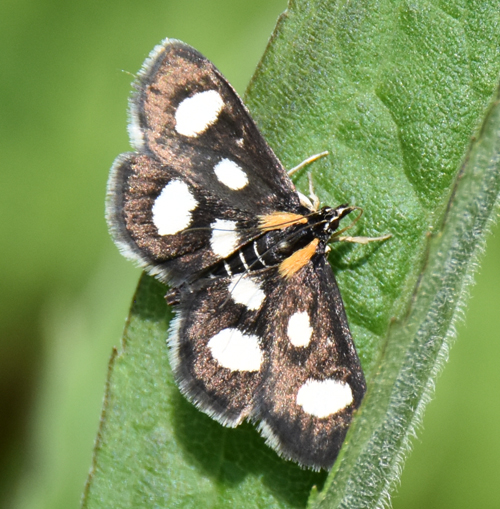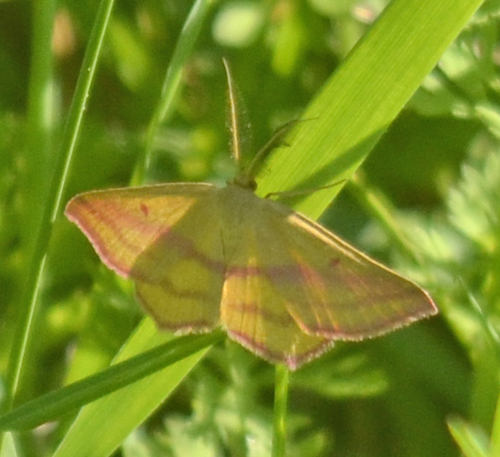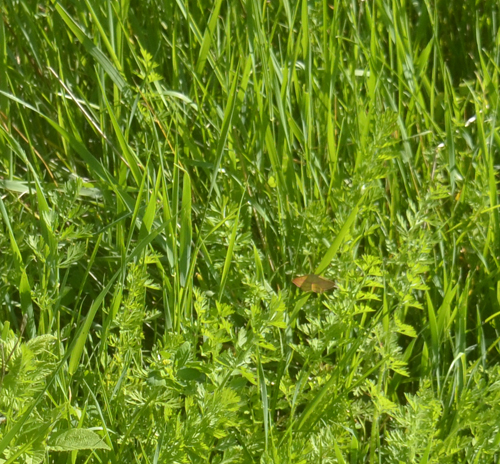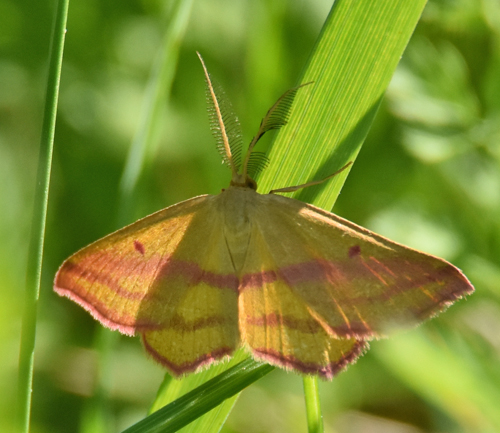Near the end of May, I took a walk through the Riverwood Conservancy in Mississauga looking for butterflies, moth and other intriguing insects. I’ve found when I start “looking for small” I notice things I’ve never seen before. This time, it was a pretty yellow – orange moth almost hidden in the tall grass at the edge of the trail in the maintenance loop.
Is This Light Orange and Pink Insect a Butterfly or a Moth?
I first glimpsed the moth when looking for any orange hints that Hobomok, Peck’s, or European Skippers were present. The colour I could see though was a much paler orange almost a rich yellow. When I got an angle from the path through the surrounding grass, I could see the shape of a moth, not a butterfly, which was confirmed when I saw the fancy antenna.
From what I’ve read, the differences between butterflies and moths are somewhat similar to the differences between fruits and vegetables. Many biologists don’t see why we are so hung up on trying to put an insect into one group or the other, instead they call them all Lepidoptera. However, if you do split them up, the antennae are a common criteria: butterflies have thin antennae, usually with a bump at the end called a club; moths have the fancy frilly antennae or long filament antennae with no clubs. Of course, there are exceptions to these “rules”! The Australia Museum website, for example, says that Sun Moths’ antennae can have clubs.
Don’t Moths Fly at Night and Butterflies in the Day?
Well, some of them do, yes. However many moths do fly in the daytime so that’s not a reliable clue. In southern Ontario, common daytime moths include White-striped Black moths, White-spotted Sables, Virginia Ctenuchas, some Haploas, and Delicate Cycnias (which I still think of as Delicate Cynthias.)

An observant Birder pointed out this White-spotted Sable to the Bird Walk participants on May 23–and I’m very happy he did!
Why Does My Yellow Moth Have More Pink Lines than the One In the Book?
The moth I found is a Chickweed Geometer. I found it on page 201 of my Peterson Field Guide to Moths. Aside from another on page 334 that was vaguely the right colours but not in the right patterns, I didn’t find any other matches. (When you are waiting for an appointment, you too may have time to look at each illustration on all 500 pages and still need to read your library book before you get called in.)
My teen observed that the butterfly in the book did not exactly match my photos. In the book, it shows a yellow butterfly with a wide pink line across the wings and a wider pink fringe along the bottom edge of the wings. The rusty partial line across the wing is also shown. And the cute pink dot on each fore wing shows up nicely.
The difference in my photo is that you can see all four wings. That means I could see two pink lines across the body and the pink line along the bottom of the wings.
Could I Interest This Chickweed Geometer In Helping Me Tidy My Yard?
As the name suggests, the caterpillars of this pretty moth eat Chickweed. I often have some growing in my yard that I could do without. I wonder if I could persuade it to lay a few eggs here?
Other weeds on its menu include clover, knotweed and smartweed. So I could actually offer it a buffet of sorts! Maybe I’ll be lucky enough to find one in my yard one spring. In the meantime, I’ll keep an eye out for another one at Riverwood.
Related Reading
- What Dark Brown Moth or Butterfly Has a Metallic Electric Blue Body and Orange Head? (Virginia Ctenucha moth)
- What Is This Black Moth or Butterfly With the Wide White Stripe on Each Wing? (White-striped Black moth)
- What Is This Grey Black Moth With 8 Large White Spots and Orange Shoulders? (White-spotted Sable moth)
- What Large Long Narrow White Moth or Butterfly Has a Thin Yellow Edge to Its Body? (Delicate Cycnia moth)
Join In
Have you seen one of these attractive moths in your neighbourhood? Please share your sighting with a comment.




